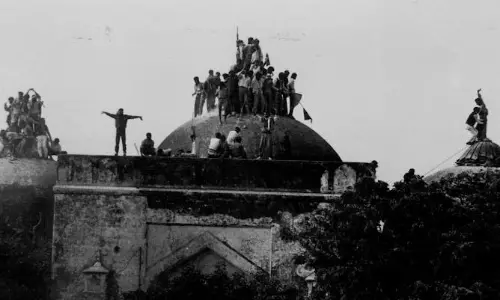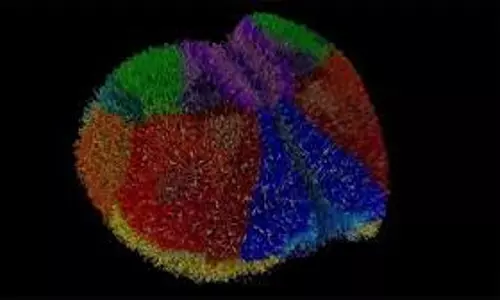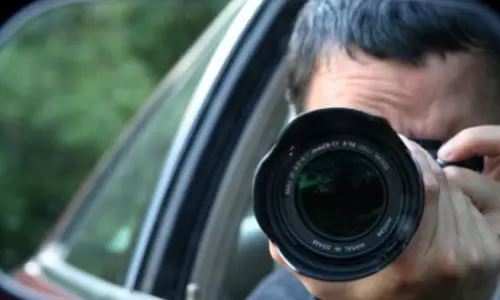
How white Aishwarya Rai is?
text_fields“This ad you figure in is insidiously racist,” said an open letter to actor Aishwarya Rai Bachchan days ago.
It took on the now-withdrawn ad of Kalyan Jewellers, where Aishwarya Rai ‘figured in’.
She looked, stately, seated with an umbrella-holding boy standing behind her. She was like a queen straight from Holly-Bolly-Kolly-Tolly wood movies and albums---with no harm whatsoever to anybody.
 When the ad was out, some people signed and posted a letter on a portal. It further reportedly described her as: “to be representing aristocracy from a bygone era - bejewelled, poised and relaxing while an obviously underage slave-child, very dark and emaciated, struggles to hold an oversize umbrella over your head".
When the ad was out, some people signed and posted a letter on a portal. It further reportedly described her as: “to be representing aristocracy from a bygone era - bejewelled, poised and relaxing while an obviously underage slave-child, very dark and emaciated, struggles to hold an oversize umbrella over your head".
The letter talks of things that fall outside the boundary of reason.
Look at the expressions in it: “Underage salve-child, very dark and emaciated”.
Dear letter-writers, you provoke many questions. Of them, one is --- “How come you’ve missed the fact that both of them are actors?"
Do you presume that they were representing something with an ‘insidious’ intent? How do you think this is going to ‘promote regressive images that are racist’? Explain. How is this image going to hamper social progress?
Now please answer how skin tone and racism are applicable to India. If exists, in what form?
India has many other social dividers, cultural compartments, strict off limits set by social status, caste and religious divides, political forces, and, above all, wealth disparities. But, skin colour? It has never been a dividing line between different people.
Even those belonging to upper class by the virtue of their birth, caste, money, social status, and political influence don’t have any ‘status-determining skin tone’. The upper caste village heads are often as dark or brown-skinned as their subjects. In some places, people belonging to lower castes do have pale skins.
 In Kerala, you can see many Brahmin priests with varying skin tones from very pale, brown and ash-dark to very dark. Factor that decides slaves in India, unlike in Europe and USA, is not skin tone at all. Your bid to contrast Mrs Rai’s pale skin with the boy’s ‘very dark’ tone in terms of social status has no ground. Because, different streams of humanity flowed in India at varying times in the history, making up varying skin tones.
In Kerala, you can see many Brahmin priests with varying skin tones from very pale, brown and ash-dark to very dark. Factor that decides slaves in India, unlike in Europe and USA, is not skin tone at all. Your bid to contrast Mrs Rai’s pale skin with the boy’s ‘very dark’ tone in terms of social status has no ground. Because, different streams of humanity flowed in India at varying times in the history, making up varying skin tones.
Sociologists say India is an ‘ethnological museum’, where you see almost all races of the world. Of them Aryan and Dravidian divide is more visible. Still, none of them could maintain their purity, because of social mixing. To put in racial terms, we have Indo-Aryans--- these tall people with prominent noses and fair skin live in eastern Punjab, Rajasthan and Kashmir.
 There is Scytho-Dravidian in Coorg and upper Madhya Pradesh. They are broad headed with medium height, fair complexion and shapely nose. And the best example of Aryo-Dravidians is those with long head and varying skin tones from light brown to black. They are mostly found in UP, Rajasthan and Bihar.
There is Scytho-Dravidian in Coorg and upper Madhya Pradesh. They are broad headed with medium height, fair complexion and shapely nose. And the best example of Aryo-Dravidians is those with long head and varying skin tones from light brown to black. They are mostly found in UP, Rajasthan and Bihar.
Coming to Dravidians, Southern Indian is generally home to them, whose dark skin, dark eyes, short stature, long head and broad nose standout from rest of the Indians. The classification doesn’t end here, because various other streaks like Turkish-Iranians also merged with general Indian populace.
As a result, not everybody in even one family has same skin tone. It is obvious from your letter that you contrasted the ‘very dark’ skinned boy with ‘bejewelled’ woman, who has pale skin. You certainly may have had trouble putting the boy in a particular race here.
How can somebody equate ‘very dark skin’ with socially oppressed?
 Now about the issue of fair skin in India. Yes, It is still a much sought-after complexion, thanks to Victorian era British presence in India. Snow-white skin in those days was a mark of elite life in Britain. Because wealthy British had a lot of indoor life, naturally their skin was snow white. For instance, read Victorian Novelist Thomas Hardy’s works for evidence. Those who work in the street and open places tend to have darker skin, so naturally they belonged to working class, and economically backward.
Now about the issue of fair skin in India. Yes, It is still a much sought-after complexion, thanks to Victorian era British presence in India. Snow-white skin in those days was a mark of elite life in Britain. Because wealthy British had a lot of indoor life, naturally their skin was snow white. For instance, read Victorian Novelist Thomas Hardy’s works for evidence. Those who work in the street and open places tend to have darker skin, so naturally they belonged to working class, and economically backward.
Since fair skin was linked to upper class life, there was a widespread obsession for snow-white skin in the UK then. Even 20th century poet like W B Yeats was particularly sad about his not-so-fair complexion.
Colonial India adapted so many things from British and this idea of fair skin was one of them. Many Indians found fair skin preferable to dark skins. However, things are changing, especially in Europe where people increasingly prefer tanned skin. If your skin is so white, it does mean one thing -- you are working all the time indoors, and you don’t have much pleasure trip and outdoor life. At its core, it means just one thing that you are not wealthy enough to take a break from work and enjoy outdoor life. Also, an increasingly number of people tan their skin to look more brown. They go to beaches or use tanning creams.
 Coming to Kalyan Jewellers ad, it unfortunately reminded some people of something from a time in history. History has many such sordid images; it is not their fault. They are just as helpless as you are unable to set things right retrospectively. Why anybody should want to cover up the unpleasant aspects of history in the first place? Does blocking of these images anyway delete them from society’s hardware?
Coming to Kalyan Jewellers ad, it unfortunately reminded some people of something from a time in history. History has many such sordid images; it is not their fault. They are just as helpless as you are unable to set things right retrospectively. Why anybody should want to cover up the unpleasant aspects of history in the first place? Does blocking of these images anyway delete them from society’s hardware?
No matter how hard we cover them up, these archetypal images will emerge.
 Have you noticed something called modern slavery, where people don’t look like ‘slave or emaciated’ at all but are slaves in many ways?
Have you noticed something called modern slavery, where people don’t look like ‘slave or emaciated’ at all but are slaves in many ways?
Today’s slave-drivers don’t hold a whip over their slaves; instead they smile their big smiles and take us for a ride. They offer us shopping malls, fast changing technology, luxury goods, social egos, and we are slave to them all. Above all, they preach the idea of happiness and teach us how to buy it.
The idea of ‘very dark’ skinned boy holding an unfurled umbrella over a queen is just archetypal. There is no point in questing it. If you are still interested in the idea of ‘dark skin’, please fight those ‘skin tone lightening’ products that promise to make all dark-skinned people ‘beautiful’.
These multinational companies equate fair skin to beauty, making all dark-skinned people ashamed of their naturally given skin tone. Try to get them banned, not a harmless ad.
(Disclaimer: The opinions expressed within this article are the personal opinions of the author. The information, facts or opinions appearing in the article do not reflect the views of Madhyamam)





















